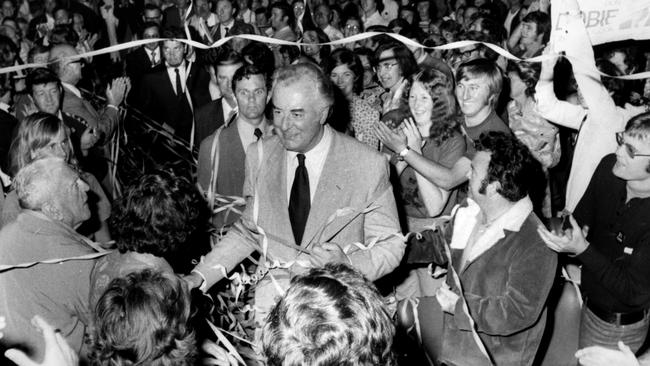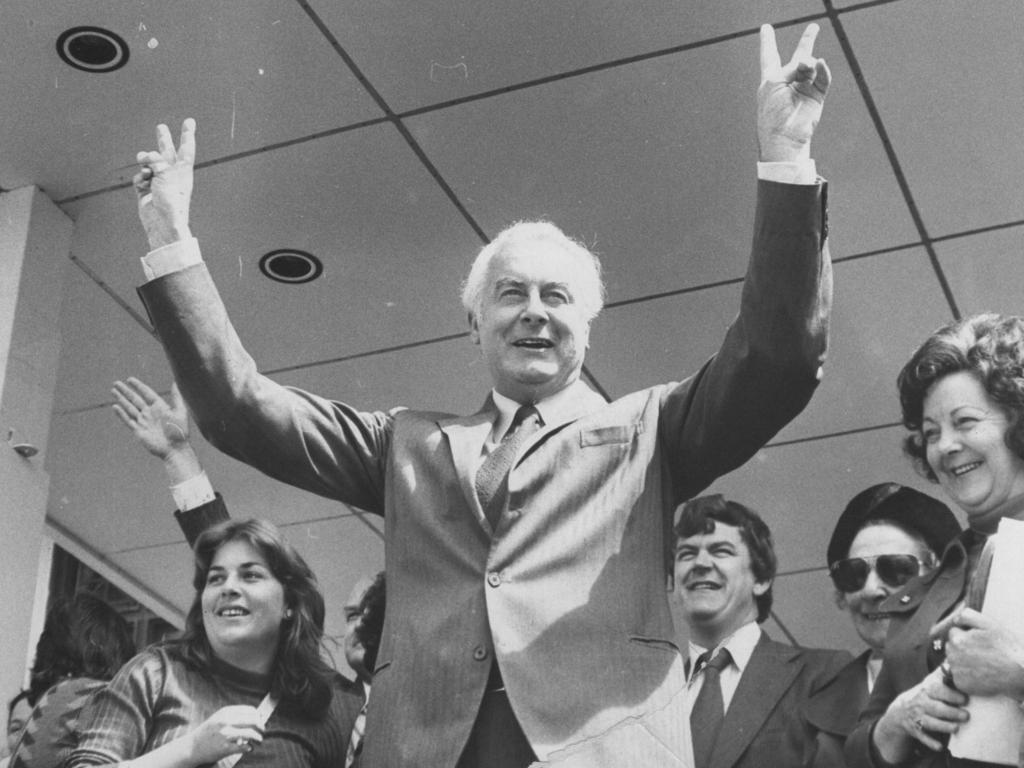Don’t gloss over the flaws when we fete Gough’s victory
The Whitlam government was not without stain – which should be remembered when the 50th anniversary of Labor’s 1972 victory is commemorated in the next two weeks.

Whitlam took over the leadership of the Labor Party from Arthur Calwell in February 1967 after Labor had lost nine elections in a row, beginning with the defeat of Ben Chifley’s government. Robert Menzies led the Coalition to victory from opposition in December 1949 and stepped down as prime minister in January 1966.
It is understandable why Whitlam became a Labor hero in 1972 – having led Labor to victory after 23 years in opposition. It was not just a matter of being a winner on election day. Whitlam, with the help of others – including the South Australian Labor MP Mick Young – was involved in the reform of the ALP Victoria branch which had been dominated by what would now be called the pro-communist left since the Labor Split in Victoria in 1955. Two years later, Labor also split in Queensland.
The Labor Split in 1955 had led to the expulsion/resignation of thousands of Labor rank-and-file members in Victoria and to the breakaway Democratic Labor Party, which gave its first preferences to the Coalition. It was the DLP preferences in Victoria and Queensland which made it possible for prime minister Menzies and prime minister John Gorton to narrowly win elections in 1961 and 1969 respectively.
Whitlam will always be a hero in Labor circles for bringing the party back from the almost dead. However, as prime minister he showed personality flaws and presided over many policy failures, particularly with respect to economics. In the end, the Whitlam government lasted but three years, which included two terms.
In normal circumstances, it is likely that Whitlam would have presided over a one-term government – the first since Jim Scullin’s Labor government in the late 1920s and early 1930s. But the circumstances were not normal. The Liberal Party, led by Billy Snedden, did not adjust to opposition. It used its Senate majority to threaten to block supply and Whitlam sought an early election in May 1974 which Labor won, but without getting a Senate majority.
Malcolm Fraser replaced Snedden in March 1975 and in October the opposition blocked supply. When Whitlam wanted to govern without supply, he was dismissed by the governor-general Sir John Kerr on November 11, 1975. Fraser was sworn in as prime minister on the condition that he held an early election. The Coalition won the election on December 13, 1975, in a landslide.
It is true that Whitlam was unlucky to come to office at a time of an international economic downturn. But it is also true that – until near the end of his second term when such Labor figures as Bill Hayden and Jim McClelland made a positive impact – Whitlam led a shambolic government. This was most evident when the left’s hero, Jim Cairns, was briefly treasurer in the mid-1970s.
Labor learnt from Whitlam’s failures. When it returned to office in March 1983 under Bob Hawke’s leadership with Paul Keating as treasurer, Labor was determined not to repeat the errors of the Whitlam government.
In his The Hawke Memoirs, Australia’s 23rd prime minister referred to “the fiscal irresponsibility” of the Whitlam government and wrote that Whitlam was “frightened by economics and finance”. Writing in The Sydney Morning Herald in March 1987, Keating commented that the Whitlam government had no policy “for dealing with inflation and unemployment”.
These were tough, but realistic assessments. The Whitlam government’s failure to manage the economy was the prime reason he led Labor to massive defeats in 1975 and again in 1977.
Certainly, the Whitlam government introduced significant social change. Although, as historian Ian Hancock pointed out in his book John Gorton: He Did It His Way, some of the policy initiatives attributed to Whitlam commenced under Gorton.
Whitlam has been praised for many initiatives he did not take. Whitlam did not abolish the White Australia policy – that process was put in place under Harold Holt’s Coalition government in March 1966 when immigration minister Hubert Opperman delivered a ministerial statement “about immigration policy affecting non-European people”.
Also, Whitlam did not withdraw Australian military forces from Vietnam. That had been done during the final years of McMahon’s Coalition government. When Whitlam came to office, only a few Australian military advisers remained in South Vietnam.
When South Vietnam fell to North Vietnam’s military forces, which were supplied by the Soviet Union, Whitlam went out of his way to prevent anti-communist South Vietnamese refugees from settling in Australia. I discussed this matter with Whitlam in late 2002/early 2003 – the correspondence is published in The Sydney Institute Quarterly, March 2003.
Whitlam has been commended for opening up Australia’s relations with China in the early 1970s. President Richard Nixon’s administration – advised by the US secretary of state Henry Kissinger – took a similar step. It’s debatable as to whether or not the Kissinger initiative had the unintended consequence of propping up Mao Zedong’s ailing Chinese Communist Party.
Whitlam seemed not to care that, when he met Mao, China had only recently recovered from what was called the Great Leap Forward – in effect, a forced famine in which an estimated 45 million died – and was in the midst of the brutal Cultural Revolution in which millions were purged and many died.
And then there was the decision of the Whitlam government in 1974 to recognise the incorporation of the Baltic States – Estonia, Latvia and Lithuania – into the communist Soviet Union at the time when Stalin’s heirs ruled in Moscow. This effectively legitimised one aspect of the notorious Nazi Soviet Pact of August 1939 whereby Hitler and Stalin effectively divided Eastern Europe between Germany and the Soviet Union.
Whitlam was a charismatic leader, which is rare in Australian politics. And he certainly made an impact. But the Whitlam government was not without stain – which should be remembered when the 50th anniversary of Labor’s 1972 victory is commemorated and/or celebrated.
Gerard Henderson is executive director of the Sydney Institute.





It’s not my intention to rain on Gough Whitlam’s parade as Australia approaches the 50th anniversary of Labor’s victory over William McMahon’s Coalition government on December 2, 1972. However, it is to be hoped that the assessment of Whitlam in the next couple of weeks will be more nuanced than that which occurred when Australia’s 21st prime minister died in October 2014.